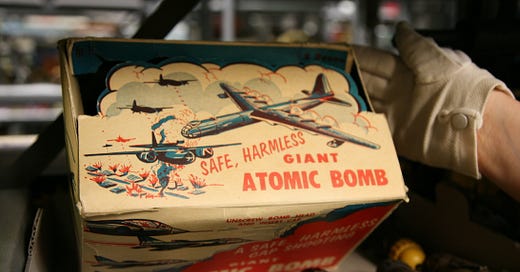Armas has been on something of a hiatus for the summer, and unfortunately it may continue a bit further into the autumn, but please rest assured it will return — and thank you for your patience. Unfortunately we must briefly emerge from this hiatus, because the news in the Ukrainian war has become, if not bad, then portentous, and it is important to understand why.
Bear with me here. There is a nuclear war at the end.
The strategic-level course of the war has gone broadly as predicted in this publication, well back in late winter. Having survived the initial shock of invasion — a survival that owed less to formal military preparedness and more to organic popular mobilization — the Ukrainian state was always going to accrete capabilities over time. Its war finances, manpower mobilization, and materiel were going to trend upward with de facto unlimited Western aid. In other words, Ukraine began the war at the nadir of its capacities, and trended upward thence. Russia has experienced the opposite trajectory: it began the war at the apogee of its finances, manpower, and materiel, and has been trending downward since. (The recent Russian mobilization in the wake of the Kharkiv defeats will not meaningfully change this, as the new armies forming will lack materiel and training in equal measure.) The only question was when the upward line of Ukrainian capability would meaningfully intersect with the downward line of Russian warmaking.
The answer: late August. The blue on the map here is Ukrainian territory liberated in the thirty days since.


The Russian state and regime, to the extent that they are separable — and they are, although this is more apparent from the perspective of the state than the regime — are therefore faced with a series of challenges. The state’s imperative is to win the war. The regime’s imperative is to survive. The problem now is that the measures necessary to achieve the one are increasingly contrary to the other. You see this clearly in the mass-mobilization decree, which tends toward the preservation of the state (albeit mostly ineffectually) at the risk of the regime. You also see it in Vladimir Putin’s hold-fast orders reportedly issued to Russian defenders at Kherson and the still-fluid northeastern front, which tend toward the preservation of the regime at the risk of the state. This is a dangerous spot in for any autocratic regime, which if unable to reconcile the two institutional imperatives will either drag the state down to destruction with it (the Germany-1945 scenario) or see itself overthrown by the stewards of the state (the Russia-1917 scenario).
We may therefore understand the actions of the Putin regime in this light. The Russian dictator and his apparatus are seeking to achieve two major ends. One is to re-unify the causes of state and regime. The other is to restore a conceptual arena for action for itself, in pushing outward a horizon of uncertainty which has been reduced to a tremendous degree by Ukrainian battlefield dynamism and the restiveness of the Russian general public. This last item may be understood as the Lyapunov horizon, and here at Armas we published a major piece on it just three days after the war began.
Keep reading with a 7-day free trial
Subscribe to Armas to keep reading this post and get 7 days of free access to the full post archives.





